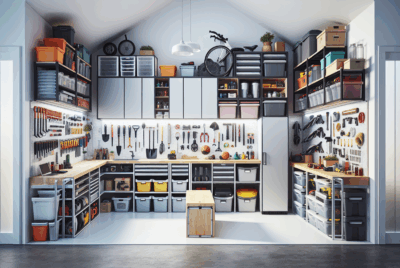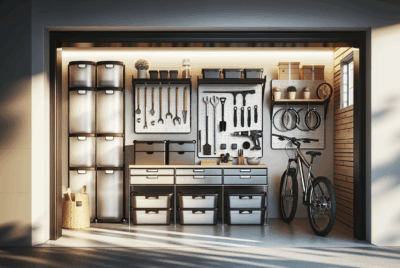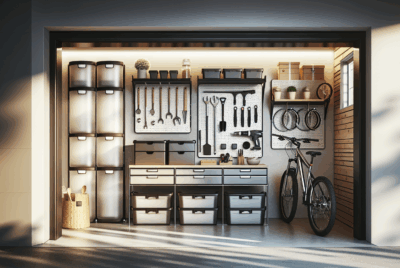Garage Floor Makeover: Transform Your Space with Stylish Solutions
As an Amazon Associate, I earn from qualifying purchases, at no additional cost to you. Disclaimer
Garage floors often get ignored, but transforming them can make a huge difference.
There’s something rewarding about turning a cold, cracked surface into a clean, inviting space.
A garage floor makeover isn’t just about aesthetics; it also adds durability and value to your home.

When I decided to revamp my garage floor, I was amazed at the options available.
From epoxy coatings to polished concrete, each choice has its strengths.
Selecting the right one can be a game changer in transforming the space.
The process itself is straightforward and worth the effort.
With the right tools and a bit of patience, anyone can achieve a stunning finish that stands up to daily wear and tear.
I found that a well-done garage floor not only improves functionality but also elevates the entire garage’s look.
Understanding Garage Floors
When preparing for a garage floor makeover, it’s important to consider the types of floors available and the advantages of keeping them in good condition.
Each type offers unique features, and a well-maintained floor can greatly benefit your home.
Types of Garage Floors
Garage flooring comes in several forms. Concrete floors are common due to their durability.
Epoxy coatings add a layer of protection and a glossy finish, making cleanup easier.
Rubber tiles provide cushioning and are simple to install. For those seeking something unique, stone or brick pavers offer a stylish option.
Choosing the right type depends on your budget, preferences, and intended use of the garage space.
Benefits of a Well-Maintained Garage Floor
Keeping the garage floor in good shape offers numerous benefits.
First, a protected floor, especially with concrete sealers or epoxy, resists stains and spills, making cleaning up spills much easier.
It also prevents cracks and extends the life of the floor.
A tidy garage floor can also improve the resale value of your home.
A well-kept floor enhances safety by reducing dust and debris. This creates a healthier environment, especially for those using the garage for hobbies or projects.
Overall, consistent maintenance results in a more enjoyable garage experience.
Garage Floor Makeover Ideas
Transforming a garage floor can enhance both its appearance and utility. By considering style and practicality, one can achieve a garage floor that not only looks good but also functions well.
Aesthetic Appeal
I love how many options there are to decorate garage floors.
Epoxy coatings offer a smooth and reflective finish and come in various colors. Stains can add rich, deep tones that highlight the floor’s texture.
Another great option is interlocking tiles. They’re available in bright colors and patterns and are easy to install.
Interlocking tiles also let me get creative with different layouts, adding a personal touch to my garage. Paint is a budget-friendly way to refresh the space with vibrant colors, allowing for quick updates.
No matter the choice, each flooring material can change the look of the garage and reflect personal style.
Functional Considerations
Functionality is crucial for garage flooring. I need to consider durability and resistance to stains and spills.
Epoxy coatings are robust and withstand heavy traffic and chemicals, making them ideal for busy garages.
Rubber mats absorb shock and noise, offering a slip-resistant surface. They’re perfect for creating a safe environment for activities or workouts.
For easy maintenance, I find vinyl roll-out flooring to be practical. It’s simple to clean and protects the floor underneath from damage.
When I select garage makeover ideas, I focus on materials that fulfill my requirements, balancing looks and utility.
Preparation and Planning

When planning a garage floor makeover, I start by looking at its current state and then decide on the best materials for the job. This helps ensure a smooth process and the best results.
Assessing Your Current Garage Floor
First, I check the condition of the floor. Is it cracked or stained? These issues need fixing before any makeover.
Cracks can easily be repaired with concrete filler. Cleaning is also important. I use a concrete cleaner to remove oil, grease, and other stains. A clean surface makes new coatings stick better.
Next, I test for moisture. High moisture levels can ruin the job.
I place a plastic sheet on the floor’s surface and wait 24 hours. If there is condensation underneath, my garage floor has a moisture problem that must be addressed.
Choosing the Right Materials
For materials, I usually lean towards epoxy or polyurethane coatings. Epoxy is durable, and it handles heavy foot traffic. It’s also resistant to chemicals.
Polyurethane is another good option, offering flexibility and UV resistance.
I also consider floor tiles, which are easy to install and replace. Rubber and foam tiles provide comfort and prevent slipping.
Another choice is acrylic sealers, which enhance the floor’s color and provide a glossy finish. Depending on my needs, each material offers unique benefits.
A simple comparison list helps me. For instance, epoxy is great for heavy use, while rubber tiles offer comfort. By comparing features, I choose what suits my garage best.
Flooring Options

When giving your garage floor a makeover, there are several flooring options to consider. Each choice offers different benefits, aesthetics, and durability levels to suit various needs and budgets.
Epoxy Garage Floor Coatings
Epoxy coatings are a popular choice for garage floors because they are durable and resistant to stains and chemicals.
Applying epoxy involves mixing resin with a hardener. Once applied, it creates a tough and glossy surface.
One of the most important things to know about epoxy is its ability to transform dull concrete into a polished surface. It’s also easy to clean and maintain.
On the downside, installing epoxy can be time-consuming. It requires a properly prepared surface and careful application.
Interlocking Garage Floor Tiles
Interlocking tiles are convenient for a quick garage floor transformation. These tiles snap together easily, requiring no adhesives.
Made typically from materials like plastic or rubber, they provide slight cushioning underfoot. They’re available in various colors and patterns, allowing me to create custom designs.
These tiles are also durable and can handle car weight without cracking. If a tile gets damaged, I can easily replace it, rather than redoing the entire floor.
Peel-and-Stick Tiles
Peel-and-stick tiles are a straightforward option for those looking to save time. These tiles have adhesive backing, making installation simple.
I just peel off the backing and place the tile on a clean floor. They are available in numerous styles, from basic designs to more decorative looks.
It’s crucial to ensure the floor is clean before applying them to prevent issues with adhesion. While not as tough as other options, they provide a quick aesthetic improvement.
Roll-Out Vinyl Flooring
Roll-out vinyl is perfect for a fast and efficient garage floor makeover. Made from vinyl, this flooring type comes in large rolls, allowing me to cover the garage floor in one continuous piece.
The installation is hassle-free—simply unroll it over the garage floor. It’s also easy to clean and comes in various colors and patterns.
One thing I like about roll-out vinyl is its flexibility and slight padding. This makes standing and working on it more comfortable. It’s suitable for areas with minimal wear and tear.
Porcelain Garage Tiles
Porcelain tiles are more luxurious and highly durable. They’re strong enough to withstand heavy loads and impacts, making them an excellent choice for garage use.
Porcelain is resistant to moisture, stains, and chemicals. This makes it long-lasting and easy to keep clean. The tiles are available in various textures and colors.
While installation can be more challenging and may require professional help, the result is a beautiful and durable flooring option. Porcelain tiles add a premium look to the garage space.
Application Techniques

When giving your garage floor a fresh look, it’s key to prepare the surface, apply paint or sealant, and possibly add tiles. I’ll guide you through the most important steps and tips.
Surface Preparation
Before diving into any application, preparing the garage floor is crucial.
First, I clean the floor thoroughly, removing any dirt, grease, or oil spots. A power washer can be handy here for tough stains.
It’s important to fill in any cracks or holes with a concrete filler.
If applying a concrete stain or an acid stain, I ensure the surface is free of any sealers, as they can prevent proper bonding.
For epoxy garage floors, it’s vital to etch the concrete to improve adhesion. This can be done using a chemical etcher or a grinding tool.
Once the floor is smooth and clean, I let it dry completely before moving on to the next step.
Painting and Sealing
Painting and sealing are two effective ways to enhance the look and durability of a garage floor.
I start by choosing a high-quality epoxy paint, known for its durability and resistance to chemicals.
Application usually involves mixing the paint thoroughly and using a roller to coat the floor evenly.
For added protection, a sealant can be applied over the paint. It’s essential to select a sealant compatible with the chosen paint.
When applying a concrete stain, I make sure to work in small sections to avoid lap marks. Acid staining requires a different approach; I apply the stain using a brush or sprayer, ensuring even coverage. After staining, I neutralize the surface with a cleaning solution and allow it to dry before sealing.
Tile Installation
For a polished look, garage floor tiles can be an excellent choice.
There are two main types: interlocking tiles and peel-and-stick tiles.
Interlocking tiles snap together and don’t require glue, making installation simpler. I recommend starting from one corner and working across the floor systematically.
Peel-and-stick tiles, on the other hand, require careful alignment. I ensure the floor is completely clean and dry before installation. Starting from the center and working outward helps achieve a uniform look.
Remember, tiles can add a layer of insulation and comfort to the garage floor while providing various design options.
Maintenance and Upkeep
Maintaining a clean and well-cared-for garage floor increases its lifespan and keeps it looking great.
Pay attention to regular cleaning routines, handle spills right away, and consider strategies for long-term care.
Regular Cleaning Tips
I find that consistent cleaning is vital for keeping garage floors in top condition.
Sweeping weekly helps remove dirt and debris that may scratch surfaces.
For painted floors or rubber tiles, mopping with a mild detergent and warm water every month makes a big difference.
Avoid harsh chemicals on rubber flooring, as they can cause damage. For stubborn spots, a soft brush can help lift the dirt without scratching the surface.
Dealing With Spills and Stains
Tackling spills quickly prevents long-term damage.
If I spill motor oil or paint, I wipe it up right away using an absorbent cloth. For grease or oil, a bit of baking soda can help soak up the residue.
Stubborn stains might need a paste of baking soda and warm water. Apply it, let it sit, then gently scrub with a soft brush. Special cleaners designed for garage floors can also be effective for more persistent stains.
Long-term Care Strategies
Considering protective sealants for painted floors helps them last longer. A sealant repels stains and resists wear.
If you have rubber flooring like me, preventive measures involve placing mats under vehicles to catch drips.
Another strategy is to arrange shelving to avoid heavy objects leaving marks on the floor.
Regular inspections for signs of wear and addressing them immediately can preserve the floor for years.
Caring for different flooring types takes specific steps but is manageable with commitment.
Additional Considerations
When planning a garage floor makeover, there are several important factors to think about. I will discuss key points related to the floor’s durability, weather factors, costs involved, and how to organize your space efficiently.
Garage Floor Durability
When picking the right flooring, durability is very important. My garage sees a lot of heavy traffic, so I prefer materials like porcelain tile.
It’s strong and resists spills and stains. Tiles are great for withstanding the weight of cars and equipment.
There are other durable options like epoxy coatings. They cover the concrete, creating a hard surface that protects against wear and tear.
Durability matters a lot if the garage is used frequently. Choose materials that stand up to the test of time.
Climate and Usability Factors
Weather impacts garage flooring choices. In cold climates, certain materials can crack.
I prefer flooring that can handle temperature changes well, like rubber mats. They provide insulation and a cushioned feel.
Porcelain tile also handles moisture well, which is essential in wet weather. It’s less likely to absorb water, preventing slips. Think about how weather might affect your garage floor.
Budget and Cost-Effectiveness
Cost is a big factor in garage floor makeovers. Epoxy is budget-friendly if you’re looking for affordability. It offers good protection without breaking the bank.
I always compare prices and quality. Investing in materials like porcelain might cost more upfront but saves money over time due to its longevity.
Making a cost-effective choice means balancing between cost and quality. Focus on long-term savings rather than just initial costs.
Accessories and Storage Solutions
Effective storage solutions transform a garage. I like using a pegboard for tools; it keeps everything organized and easy to find.
A pegboard maximizes wall space, reducing clutter.
Hanging small items and hardware makes the space feel tidy and usable.
Consider installing shelving units to store bins and bulky items. They keep the floor area clear. Using durable storage options like these makes finding what you need quicker and easier.
Frequently Asked Questions
When giving a garage floor a new look, I often consider different resurfacing options, the right floor paints, and various costs and time commitments. DIY solutions can also bring noticeable improvements.
What are the best options for resurfacing a garage floor?
In my experience, epoxy coatings, concrete stains, and interlocking tiles are among the top choices. They offer different looks and benefits.
Epoxy provides a glossy finish, while stains add color without covering the natural concrete appearance. Interlocking tiles are durable and easy to install.
What considerations should be made when choosing garage floor paints or coatings?
I find that durability, ease of cleaning, and appearance are key factors.
Some paints are more resistant to oil stains and tire marks, which is essential for long-lasting performance.
It’s also important to choose a coating that matches the desired look and is within my budget.
How does epoxy compare to other garage floor covering options in terms of durability and cost?
Epoxy stands out for its high durability and resistance to wear and tear. It’s ideal for heavy-duty use.
While usually more costly upfront, its long lifespan offers value over time. Compared to other options like paint or tiles, epoxy can provide a unique balance between cost and durability.
What is the typical cost range for garage floor replacement?
A garage floor makeover can vary widely in cost. In most cases, prices range from $3 to $10 per square foot, depending on the materials and labor involved.
Many factors, like the size of the space and chosen materials, affect the final expense.
How long does a garage floor makeover typically take to complete?
Based on my experiences, a full garage floor makeover usually takes about one to three days, depending on the size and scope of the project.
Epoxy coatings may require additional drying time, extending the process.
Are there any DIY solutions for improving the appearance of a garage floor?
For those interested in DIY, painting the floor with a high-quality concrete paint or using self-adhesive tiles is a viable option. These may not offer the durability or look of professional jobs, but they can still provide a noticeable improvement without the higher costs of hiring contractors.



